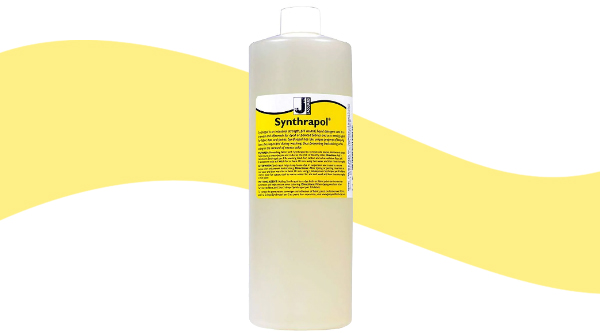What the heck is…Synthrapol
Author: Cheryl Kilbourne-Kimpton

This posting begins a series on particular products we feel you may want to consider adding to your “kit”. Periodically, we’ll highlight some esoteric item that will make your life easier and share it with you.We begin today with the special detergent Synthrapol, used in several phases of dyeing; it is composed of water, isopropanol* and detergent. It will remove sizing from the fabric before coloring, remove excess dye, and, my favorite use, it serves as a concentrated wetting agent, i.e., a surfacant.
Please, don’t glaze over in anticipation of a return to the dreaded Chem class. This will be quick and, actually, kind of cool.
A surfacant is a substance that tends to reduce the surface tension of a liquid in which it is dissolved, in this case facilitating even color distribution. All detergents are composed of long thin molecules with polar opposite ends. One end is hydrophobic, it is repelled by water, and, therefore, clings to oil (your excess dye) while the other is hydrophilic, that’s right, it’s drawn to water. One end of the molecule wraps around the dye while the other propels it away from the fabric holding it suspended in the water so it can easily rinse away. If you take a moment and visualize it, it is really remarkable.
How I use it: I dissolve the dye in the washing machine tub filled with hot water (140°F) and add a capful of Synthrapol. I have found the dye invariably distributes evenly. Some manufacturers disagree on the exact amount recommended. Companies with laboratory experience offer disparate quantity recommendations, my capful, however, has consistently worked in the field. Basically, a little bit of this product goes a long way to giving you a better product in a difficult job.
While Synthrapol is the best “tool” for this job, in a pinch, I’ve had success by adding a couple of drops of hand dish soap to the tub.
* the State of California has determined that isopropanol (rubbing alcohol) is “known…to cause reproductive harm.” The reality is, pregnant women should eschew the dyeing process all together.
Cheryl (with Roger Kimpton)
Thanks for this great article on synthrapol! I love your store and the ladies who work there are helpful and smart and nice as can be!